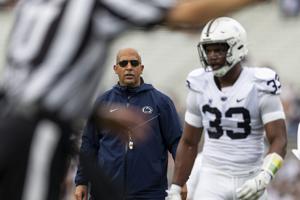PSU’s Franklin: Revenue sharing with players ‘inevitable’

STATE COLLEGE, Pa. — Penn State coach James Franklin believes major college football players will inevitably be paid and the sooner it happens the better it will be for all involved with the sport.
In an interview this week with The Associated Press, Franklin said that while college sports leaders are focused on finding ways to regulate how athletes are compensated for use of their name, image and likeness, a bigger change is on the horizon.
“I also think that ultimately, whether it’s in the next three years or next five years or next two years, there’s going to be some form of revenue sharing or collective bargaining agreement (with the players),” Franklin told AP. “That’s going to happen. I think that’s inevitable.
“And I think most people would prefer that than the current model because I think it’s better for the student-athletes because they’re going to be able to get contracts and know what they’re signing up for. And I think for the schools as well, I think there’s going to be value in knowing what you’re dealing with.”
People are also reading…
Television networks pay billions of dollars to college conferences for the media rights to their sporting events, value mostly driven by football.
The Big Ten, Penn State’s conference, will make more than $7 billion over seven years from contracts it signed with multiple networks last year; Big Ten schools —- there will be 16 of them beginning in 2024 — could receive something like $100 million per year from the league during the length of the new deal.
The rise in media rights fees has led to skyrocketing salaries for college football coaches, sparking criticism that the wealth is not being shared with players. Franklin is in the second-year of a 10-year contract with Penn State that pays him $8.5 million annually. He is one of about a dozen major college football coaches whose annual salary surpasses $8 million.
Franklin is 78-36 in nine years with the Nittany Lions, including an 11-2 record and Rose Bowl victory last season.
The combination of loosened transfer rules that allow college athletes to switch schools more freely than ever before and permissible NIL payments have left many coaches lamenting the difficulty of managing a roster.
Franklin mentioned a bill working its way through the California legislature that would require some NCAA Division I schools to share revenue with athletes in revenue-generating sports such as football and basketball as a possible catalyst toward pay-for-play.
The College Athlete Protection Act, introduced by Assembly member Chris Holden in January, took a step toward passage this week when it passed the Higher Education Committee on Monday.
“We owe it to these young people to put protections in place that match the unique position they are in and set them up for success post schooling,” Holden said in a statement.
There is also a federal lawsuit in Pennsylvania that seeks employment status for college athletes.
Franklin said the Supreme Court’s unanimous decision against the NCAA in 2021 made it obvious the law was not on the side of the so-called collegiate model of amateurism and that college football players, in particular, would need to be paid.
“So, I think pretty much everybody I talk to is in the camp of, you know, this needs to happen and should have happened for a long time,” Franklin said.
North Carolina coach Mack Brown recently told Sports Illustrated that college football is now the “mini-NFL” and said he hated the loss of amateurism. For its part, the NCAA is counting on Congress to enact federal law addressing athlete compensation.
Franklin told AP college football was trending toward a professional model long before the NCAA lifted a ban on NIL compensation for athletes in 2021.
Franklin compared rule changes in the last decade that restrict official team activities for college athletes —- not including competitions — to 20 hours per week and place limitations on contact at football practice to similar parts of the NFL’s collective bargaining agreements.
Like the NFL, the relationship between players and coaches in college football has become similar to a partnership, Franklin said.
“And I think if you go to college practices and spend time around college programs and how the coaches and players interact, it’s more of an NFL-model in terms of hey, we’re all working together to accomplish something rather than in the old days,” he said. “It was very much the coach was here and the player was here. And it was my way or the highway. That, for the most part, that’s been gone for a long time.”
For all the latest Sports News Click Here
For the latest news and updates, follow us on Google News.

